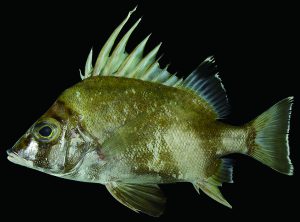Abstract / Introduction / Summary:

The banjosfish genus Banjos (Perciformes: Banjosidae), characterized by dorsal fin usually with 10 spines and 12 soft rays, membrane of spinous portion strongly incised, long and flat anterior spines and the longest spine subequal to head length; anal fin usually with strong 3 spines and 7 soft rays; small conical teeth on both jaws and vomer, no teeth on palatines; preopercle, interopercle and subopercle finely serrated; posterior parts of cleithrum, supracleithrum and posttemporal exposed with finely serrated margin; branchiostegal rays 6; and vertebrae 25, comprises three valid species [viz., Banjos banjos (Richardson, 1846), Banjos aculeatus Matsunuma and Motomura, 2017 and Banjos peregrinus Matsunuma and Motomura, 2017], distributed in the western Pacific Ocean from Japan to Australia and the southeastern Indian Ocean at relatively deep habitat (Matsunuma and Motomura, 2017). Furthermore, Banjos banjos can be separated into two valid subspecies, the northwestern Pacific Ocean subspecies B. banjos banjos (Richardson, 1846) and the southeastern Indian Ocean subspecies B. banjos brevispinis Matsunuma and Motomura, 2017 (Matsunuma and Motomura, 2017). Four specimens of the genus Banjos, collected from Amami-oshima island, were subsequently identified as B. banjos (subspecies B. banjos banjos). This is the only species of the genus Banjos currently represented in Japanese water, recorded from Kanagawa to Okinawa prefectures (see the detailed distribution in Matsunuma and Motomura, 2017). In Kagoshima Prefecture, B. banjos has previously been reported from southwestern coast of Kyushu to Kuchino-shima island (Matsunuma and Motomura, 2017) and Amami-oshima island (Suzuki, 1964; Suzuki et al., 1964; Fujiyama, 2004). However, the previous reports of this species from Amami-oshima island presented photographs only, no specimens were deposited in any fish collections in museums. In addition, ichthyofaunal surveys had recently been conducted in Amami-oshima island by Nakae et al. (2018), but specimens of Banjosidae had never been collected during this survey. Therefore, the specimens of B. banjos banjos examined in this study represent the first specimen-based record of the species from Amami-oshima island.
